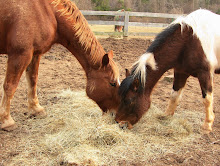We constantly strive to build a
deeper connection with our horses. We know that if we do, we'll build a
relationship of trust and understanding with our horses, so that our riding and
training achieves a greater state of balance and harmony.
Jenny Rolfe, author of Breathe Life into Your Riding, has accomplished
just this. In her book, she provides exercises to release tightness in your
body created by tension. Her teaching will help you not only to ride in good
posture and balance, but also cultivate a deep sense of connection and feel.
Learn more from Jenny Rolfe
from this article featured in Dressage
Today magazine:
Years ago, I wish I had
understood the
power of core breathing to enhance a deep connection with the horse.
Everyone who becomes successful as an athlete, dancer, singer or martial artist
has understood how to master breathing techniques to enhance their performance.
Core breathing is an extremely potent tool that can help us connect with our
horse. The power of less stimulation will quickly create a more sensitive
response. Our calm, focused state of mind will help us to communicate with more
awareness and perception. The horse is an extremely sensitive herd animal, so
we can use this trait to gain more subtle communication. The language of the
horse is to be constantly aware of changes in body language, tension and
breathing.
Correct core breathing is
similar to filling a glass of water from bottom to top. Once the glass is full,
you empty it from top to bottom. This is similar to our pattern of breathing.
The outward breath releases through our upper torso and flows down into our
core. In this way, balance and energy flow can be controlled by our breathing.
Try this exercise, which demonstrates how core breathing can create more
energy: Pick up a ball and throw it to a partner with no focus at all on your
breathing. Then as you prepare to throw the ball again, take a deep inward
breath. As you release and throw the ball, exhale strongly and direct the
energy toward your hand. As you direct the energy from your breath into your
arm, the ball will be thrown with much more intense power and speed.
In much the same way, our
breathing can influence a sensitive horse. Here are some examples: To ride an
upward walk–trot–walk transition (forward and in an energetic rhythm), prepare
by taking a deep, inward breath. Exhale strongly, whilst feeling the energy
ripple down through your spine. This releases your core and mobilizes your
seat. Use your legs once, if necessary, but the horse will quickly tune into
your breathing alone.
|
|
Written to empower trainers
and riders of all levels and disciplines, Breathe Life Into Your Riding
offers breathing techniques that enable riders to improve their:
|
To prepare for a trot-canter
transition on the right rein, first make sure your horse is balanced with
sufficient energy and working correctly on the circle. To prepare, take a deep,
inward breath and feel your horse re-balance. Then take a deeper exhalation
whilst allowing your inside (right) shoulder and leg to move slightly forward.
As you exhale, breathe into your inside (right) seat bone, which will release
and energize the canter strike off. Allow the elevation of the movement through
your upper torso.
Try this to visualize this
feeling: Walk for a few strides, then prepare to take a step upward, as if
climbing a staircase. As you place your foot on the stair, your upper body has
to elevate to allow the space for your body to lift. In a much more subtle way,
this is similar to the feeling of elevation within the upper torso when you
ride. The
power from the hind limbs of the horse create more lightness and mobility
within his shoulders. This elevation can become blocked if the movement is not
absorbed by the upper torso of the rider.
To ride a downward walk-halt
transition, take a deeper inhalation, which will lengthen and strengthen your spine,
creating stability and acting as a half halt. As the horse responds, increase
the inward breath and close your fingers on the reins and your legs on the
girth. Once the horse is standing still, release the pressure of your fingers
on the reins and allow the horse to halt in a good self-carriage. He should be
calm and still yet ready to move forward in response to your next deeper
energizing exhalation.
Collection can also be
enhanced. Relax your jaw and breathe into “allowing shoulders” to support the
movement of your spine. This enhances fluidity as energy is harnessed and
released, like a wave in the sea. It encourages a feeling of pride and also
lightness in the upper body, which can more efficiently absorb the extra uphill
movement of the horse within collection. These breathing
techniques can be the essence of developing passage and lightness
where the rider not only moves with the horse but breathes with the movement.
Encourage your horse to listen
to your core breathing as your first aid when asking for any change, whether in
pace or direction. Techniques of breathing can energize a lazy horse or calm
anxiety, thus creating more harmony. The horse will quickly understand that
this is the way of going without the constant pressure of leg aids from the
rider. Excess pressure from our legs against the rib cage creates discomfort
and tension for the horse.
These techniques are a journey
of discovery and empowerment. When we listen to our horse, we can gain both
empathy and harmony—he will become the mirror of our mind.
Loretta
the natural horseman
clear communication/visible results






